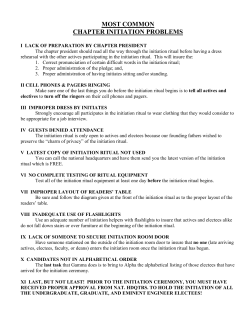
Multi-borehole electro-blast method for concrete monolith splitting off
Home Search Collections Journals About Contact us My IOPscience Multi-borehole electro-blast method for concrete monolith splitting off This content has been downloaded from IOPscience. Please scroll down to see the full text. 2014 J. Phys.: Conf. Ser. 552 012028 (http://iopscience.iop.org/1742-6596/552/1/012028) View the table of contents for this issue, or go to the journal homepage for more Download details: IP Address: 176.9.124.142 This content was downloaded on 19/11/2014 at 09:55 Please note that terms and conditions apply. International Congress on Energy Fluxes and Radiation Effects (EFRE-2014) IOP Publishing Journal of Physics: Conference Series 552 (2014) 012028 doi:10.1088/1742-6596/552/1/012028 Multi-borehole electro-blast method for concrete monolith splitting off A S Yudin*, N S Kuznetsova, V V Lopatin and N V Voitenko Tomsk Polytechnic University, Lenina av. 30, Tomsk, 634028, Russia E-mail: tevn@hvd.tpu.ru Abstract The multi-borehole method of monolith splitting off by pulsed electrical discharge is presented. The experimental data of simultaneous and step by step discharge initiation for monolith splitting off with using of the polyethylene cartridge are given. The simultaneous initiation of discharge in two boreholes with 30 cm spacing, transferred energy in each borehole about 23 kJ as well as sequential initiation of discharge with transferred energy in one borehole about 47 kJ are investigated. The concrete splitting off with the dimensions of 300×300×650 mm by six boreholes with step-by-step initiation in each borehole and with total energy of about 280 kJ as well as the concrete splitting off with dimensions of 300×300×300 mm by the four boreholes with simultaneous initiation in each two boreholes and the total energy of about 90 kJ take place. It is shown that the simultaneous multi-borehole initiation of the electrical discharge leads to the cracks formation in predefined direction and to the directional solid splitting off. The experimental results show that the simultaneous discharge initiation in comparison with step-by-step one has advantage in consumed energy. 1. Introduction In mining industry, building and construction sector for dismantling and repair of buildings, construction or expansion of tunnels, deepening of bed, removing the debris, etc. there are tasks of demolition and splitting off monolith of large solid blocks of natural and artificial origin (lumps of rock, concrete blocks and items) – “oversizes”. Traditionally the explosive, mechanical or thermal methods for such tasks are used. These methods have some shortcomings. The mechanical method is safe for workers and the environment. It should be noted, however, that in case of high-strength materials it does not always provide the desired technological effect. Thermal methods are based on using thermodrills or termite compositions. The thermodrills are mainly used for the destruction of “oversizes” and include a sufficiently complex equipment. The process of destruction with using of termite compositions proceeds rapidly, does not lead fragment dispersion, though for the complete destruction requires additional mechanical force. Explosives due to its simplicity and high performance are used in the most industrial environments. It allows destroying the objects practically of any size and strength. The disadvantages of this method include the environmental hazard of explosives, dust and debris, during the expansion that can damage surrounding objects. In consequence of it there is a requirement to ensure the security zone and the evacuation of staff while carrying out of blasting is needed. This method also requires a precise execution order because blasting strictly regulated by state regulatory authorities. In dense urban areas usage of explosives is limited, and in most cases it is prohibited. It should also be noted that the effectiveness of explosive method falls down when dimension of destructed object decreases, especially when sizes is less than 0,8 ÷ 1m. Content from this work may be used under the terms of the Creative Commons Attribution 3.0 licence. Any further distribution of this work must maintain attribution to the author(s) and the title of the work, journal citation and DOI. Published under licence by IOP Publishing Ltd 1 International Congress on Energy Fluxes and Radiation Effects (EFRE-2014) IOP Publishing Journal of Physics: Conference Series 552 (2014) 012028 doi:10.1088/1742-6596/552/1/012028 One of the promising direction of splitting off and destruction of solid materials is using pulse electric-discharge method, the essence of which is application of the electro-burst wave dynamics principles [1-3]. When a current impulse flows through the plasma channel of capillary electric discharge in condensed matter, due to the rapid energy release in the channel, the shock wave of pressure is generated. It forms the field of mechanical stresses, causing the material destruction. In this paper the comparison between simultaneous and step-by-step discharge initiation for monolith splitting off with using of pulse electric-discharge method is presented. 2. Design of the equipment The electric circuit diagram of the generator that was used in experiments is shown in figure 1. The generator includes energy storage – nonpolar capacitor battery C consisting of 40 capacitors of K75101-15kV-14uF type, and pseudo-spark switch S of TDI1-200k/25 type. The maximum charging voltage is 15 kV and the maximum energy stored in the battery is 63 kJ. To prolong the lifespan of the capacitors the charging voltage under working conditions is reduced to 13 kV. Elements R and L are the stray parameters of the circuit that were estimated from the short-circuit experiment. Rch is the discharge channel resistance that vary with the time. Its mean value was estimated from the experiments as approximately 0.03 Ohm. The length of discharge channel is 100 mm. The channel was initiated with a thin copper wire with diameter of 0.2 mm. It was done to simplify the ignition of initial discharge channel under relatively low voltage of 13 kV. Figure 1. Electric circuit diagram of the generator. As it was precisely described in [4], to increase the amplitude of shock waves and step up the efficiency of its transfer to the destructible material, the polyethylene cylinder with copper wire in its axis was used as a cartridge. The outer diameter of the cartridge is equal to the inner diameter of the borehole in the destructible material and is equal 26 mm. 3. Description of experiments All experiments were carried out with concrete specimen situated in ground. It was done to decrease the amplitude of reflected shockwaves to simulate real conditions in monolith. The dimensions of specimen was (W×H×D) 1000×1000×2000 mm. Compressive strength of used concrete was 40 MPa. Tektronix TDS-2024 oscilloscope and CWT-1500 Rogowsky coil were used to record the discharge current waveform. 4. Results of experiments Typical current waveforms for sequential and simultaneous initiation modes are shown in figure 2. Normally the two half-periods occurred during the discharge. In some cases one or three half-periods occurred and it depends on conditions around the plasma channel. 2 International Congress on Energy Fluxes and Radiation Effects (EFRE-2014) IOP Publishing Journal of Physics: Conference Series 552 (2014) 012028 doi:10.1088/1742-6596/552/1/012028 (a) (b) Figure 2. The current waveforms of the discharge: (a) – one electrode in sequential initiation mode; (b) – two electrodes in simultaneous initiation mode. 3.1. Simultaneous initiation in two boreholes In the first experiment two boreholes with 35 cm spacing were bored vertically, and two boreholes – horizontally with 35 cm of depth. The initial state of concrete specimen and installed electrodes are shown in figure 3a. (a) (b) (c) Figure 3. The result of the experiment with simultaneous initiation in two boreholes: (a) – the scheme of boreholes before discharge; (b) – cracks pattern after first discharge; (c) – fracture pattern after second discharge (Bar 100 mm). The simultaneous initiation of discharge in two vertical boreholes was produced. As one can see in figure 3b the major cracks were formed after the discharge and they were oriented in the plane of the boreholes. Such scheme helps to produce splitting off in the predefined direction. After second simultaneous discharge in two horizontal boreholes the same cracks pattern were formed. The size of each main crack in its mouth near the borehole was approximately from 1 to 3 mm. It needs to be mentioned that final splitting off was obtained with additional manual power with the help of electric hand perforator. The result of the experiment is shown in figure. 3c. The dimensions of split part was about 300×300×300 mm. Total consumed energy in this experiment was approximately 90 kJ. 3.2. Sequential (step-by-step) initiation Sequential initiation of the discharge was produced in accordance with the scheme shown in figure 4a. The discharge was initiated once in each borehole. The borehole depth was approximately 35 cm, the distance between the boreholes was between 30 and 35 cm, the energy in each pulse was about 47 kJ. The boreholes 1–3 was vertical and 4–6 was horizontal. The result of destruction after 5 and 6 pulses is shown in figure 4b,c. 3 International Congress on Energy Fluxes and Radiation Effects (EFRE-2014) IOP Publishing Journal of Physics: Conference Series 552 (2014) 012028 doi:10.1088/1742-6596/552/1/012028 After the discharge in each borehole the two or three main cracks were formed. The mouth width of all cracks near the borehole was about 1÷3 mm. After the second and subsequent discharges one of the main cracks was generally directed to previous borehole. The complete destruction of the concrete bounded by boreholes was induced by discharges in 5th and 6th boreholes. There was no additional manual power in this experiment, but consumed energy is three times higher and equals to about 280 kJ. (a) (b) (c) Figure 4. The result of the experiment with step-by-step initiation in six boreholes: (a) – the scheme of boreholes, 1–6 – numbers of boreholes; (b) – fracture pattern after 5th discharge; (c) – fracture pattern after 6th discharge (Dimensions in millimeters, bar 100 mm). 5. Conclusion The concrete splitting off with dimensions of 300×300×300 mm by the four boreholes with simultaneous initiation in each two boreholes and with total energy of about 90 kJ take place. Also the concrete splitting off with the dimensions of 300×300×650 mm by the six boreholes with step-by-step initiation in each borehole and with total energy of about 280 kJ takes place. It is shown that the simultaneous initiation of the electrical discharge leads to the cracks formation in predefined direction and to the directional solid splitting off. The experimental results show that the simultaneous discharge initiation in comparison with step-by-step one has advantage in consumed energy but needs additional manual power. Next step in this research is to try to initiate discharge in adjacent boreholes with the time delay for wave propagation from the first borehole to the second one. This method will help to increase the pressure wave amplitude in the second borehole and will correspondingly help to form more cracks in the material. Acknowledgement This work was supported by Federal target program, project No 14.575.21.0059, and RFBR, research project No 14-08-01088/14. References [1] Kuznetsova N S , Lopatin V V, Burkin V V, Golovanevsky V A, Zhgun D V, Ivanov N A 2011 Theoretical and experimental investigation of electro discharge destruction of nonconducting materials IEEE International Pulsed Power Conference: Digest of Technical Papers (Chicago, June 19-23, 2011) (Chicago: University of Missouri) pp 267–271. [2] Burkin V V, Kuznetsova, N S, Lopatin V V 2009 Dynamics of electro burst in solids: I. Power characteristics of electro burst. J. Phys. D: Appl. Phys. 43 185. [3] Bluhm H, Frey W, Giese H, Hoppé P, Schultheiß C, Sträßner R 2000 Application of Pulsed HV Discharges to Material Fragmentation and Recycling IEEE Transactions on Dielectric and Electrical Insulation 7 N5 625 4 International Congress on Energy Fluxes and Radiation Effects (EFRE-2014) IOP Publishing Journal of Physics: Conference Series 552 (2014) 012028 doi:10.1088/1742-6596/552/1/012028 [4] Kuznetsova N S, Burkin V V, Lopatin V V, Golovanevsky V A, Stefanov Y P, Ivanov N A, Yudin A S 2012 Blast-Hole Electrofracture of Oversize Rocks J. Iizvestiya vuzov. Fizika. 55 N10/3 232 5
© Copyright 2025











